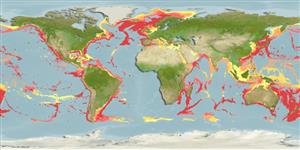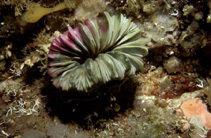Desmophyllum dianthus (Esper, 1794)
Cockscomb cup coral| Native range | All suitable habitat | Point map | Year 2050 |

|
| This map was computer-generated and has not yet been reviewed. |
| Desmophyllum dianthus AquaMaps Data sources: GBIF OBIS |
Classification / Names Common names | Synonyms | CoL | ITIS | WoRMS
Anthozoa | Scleractinia | Caryophylliidae
Environment: milieu / climate zone / depth range / distribution range Ecology
Reef-associated; depth range 8 - 2500 m (Ref. 87801), usually 200 - 2500 m (Ref. 120488). Subtropical; 8°C - 14°C (Ref. 87801); 83°N - 56°S, 180°W - 180°E
Distribution Countries | FAO areas | Ecosystems | Occurrences | Introductions
Cosmopolitan. Tropical to polar.
Length at first maturity / Size / Weight / Age
Maturity: Lm ? range ? - ? cm
Maximum depth from Ref. 120488. Can be found in deep waters (Ref. 122680). Azooxanthellate, found in deep reefs (Ref. 116012). Known from circalittoral and bathyal zones (Ref. 810) at depths 2 to 2460 m. It inhabits rock walls, boulder grounds, or biogenic hard substrates like mussel shells in areas with moderate to strong current exposure (Ref. 87801).
Life cycle and mating behavior Maturity | Reproduction | Spawning | Eggs | Fecundity | Larvae
Members of the class Anthozoa are either gonochoric or hermaphroditic. Mature gametes are shed into the coelenteron and spawned through the mouth. Life cycle: The zygote develops into a planktonic planula larva. Metamorphosis begins with early morphogenesis of tentacles, septa and pharynx before larval settlement on the aboral end.
Main reference
References | Coordinator | Collaborators
Waller, R.G. and P.A. Tyler. 2005. (Ref. 810)
IUCN Red List Status (Ref. 130435)
CITES status (Ref. 108899)
Appendix II: International trade monitored
CMS (Ref. 116361)
Not Evaluated
Threat to humans
Human uses
| FishSource |
Tools
More information
Age/Size
Growth
Length-weight
Length-length
Morphology
Larvae
Abundance
Growth
Length-weight
Length-length
Morphology
Larvae
Abundance
Internet sources
BHL | BOLD Systems | CISTI | DiscoverLife | FAO(Publication : search) | Fishipedia | GenBank (genome, nucleotide) | GloBI | Gomexsi | Google Books | Google Scholar | Google | PubMed | Hexacorallians of the World | Tree of Life | Wikipedia (Go, Search) | Zoological Record
Estimates based on models
Preferred temperature
(Ref. 115969): 2.7 - 12.7, mean 6.8 (based on 2399 cells).
Price category
(Ref. 80766):
Unknown.



